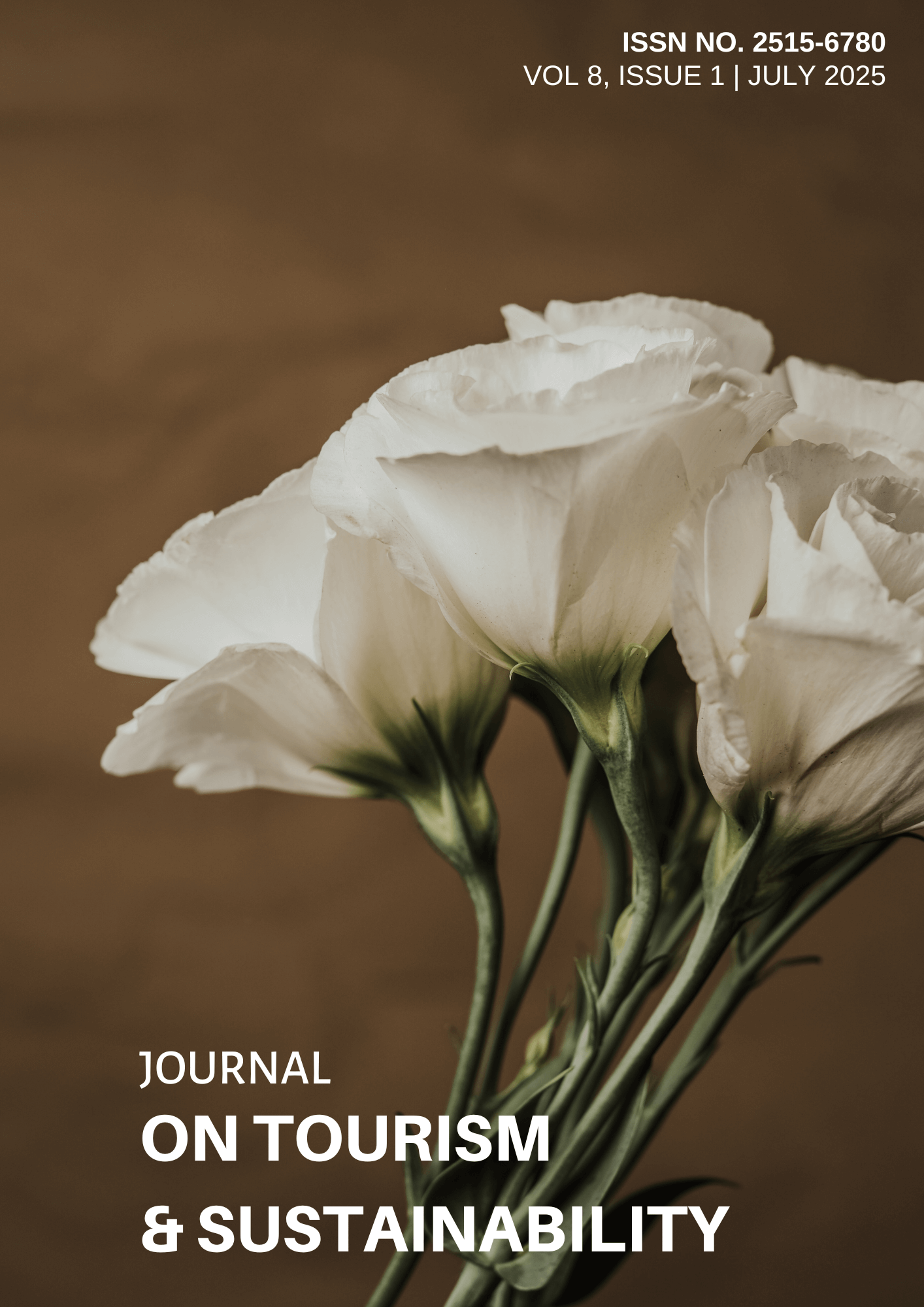Food Tourism Overview Of Nepal
DOI:
https://doi.org/10.5281/zenodo.16319907Abstract
Tourism is a significant service industry in Nepal which generates revenue for locals. Tourism has evolved from a focus on sight-seeing to a more holistic approach, incorporating taste, touch, sound, and smell. Food tourism is a new form of travel that values diverse experiences and appearances, transforming the way people travel and creating new identities. Researchers study the connection between tourism and food, examining topics like caterers' use of local foods, competition for land and workers, and tourists' food choices. Food tourism promotes cultural awareness and understanding of place and identity through the consumption of food, protecting natural resources, improving people's lives, and preserving traditional foods and methods. Food tourism strategies are crucial for regional growth, as they can work together to improve both sectors (Hall, 2004). Gastronomy tourism involves traveling to destinations primarily for the purpose of experiencing local cuisine and beverages. Gastronomy tourists can be classified into gourmet tourists, gastronomic and culinary tourists, and gastronomic tourists. Postmodern tourists increasingly prioritize food and cooking as a means of self-definition, with locally sourced cuisine allowing travellers to directly experience and immerse themselves in a particular area and its cultural heritage. Whatever may be the attraction, food remains the key factor in selecting a destination, as it reflects the culture and traditions of a community. Native cuisine attracts foreigners due to its native resources and presentation. Food serves not only as a source of revenue but also as a tool to safeguard tourism in certain countries. The presence of food as a tangible manifestation of cultural and traditional identity is a major draw for tourists worldwide.References
Ainley, S. (2011). Food, agri-culture and tourism. Linking local gastronomy and rural tourism: Interdisciplinary perspectives. Leisure/Loisir, 35(4), 481–482. https://doi.org/10.1080/14927713.2011.648407
Bélisle, F. J. (1983). Tourism and food production in the Caribbean. Annals of Tourism Research, 10(4), 497–513. https://doi.org/10.1016/0160-7383(83)90005-1
Bell, D., & Valentine, G. (2013). Consuming geographies. Routledge. https://doi.org/10.4324/9780203349656
Brotherton, B. (1999). Towards a definitive view of the nature of hospitality and hospitality management. International Journal of Contemporary Hospitality Management, 11(4), 165–173. https://doi.org/10.1108/09596119910263568
Burns, P. M., & Novelli, M. (2006). Tourism and social identities. Routledge.
Canavari, M., Huffaker, C., Mari, R., Regazzi, D., & Spadoni, R. (2011). Educational farms in the Emilia-Romagna region: Their role in food habit education. In Food, Agri-Culture and Tourism (pp. 73–91). Springer. https://doi.org/10.1007/978-3-642-11361-1_5
Cook, I., & Crang, P. (1996). The world on a plate. Journal of Material Culture, 1(2), 131–153. https://doi.org/10.1177/135918359600100201
Dashper, K. (2015). Rural tourism: An international perspective. Cambridge Scholars Publishing.
Doshi, S. L. (1995). Anthropology of food and nutrition. Rawat Publications.
Douglas, I., Douglas, I., Hugget, R. J., & Robinson, M. (2003). Companion encyclopedia of geography: The environment and humankind. Routledge.
Eastham, J. (2003). Valorizing through tourism in rural areas: Moving towards regional partnerships. In C. M. Hall, L. Sharples, R. Mitchell, N. Macionis, & B. Cambourne (Eds.), Food Tourism Around the World (pp. 228–248). Elsevier. https://doi.org/10.1016/b978-0-7506-5503-3.50016-6
Everett, S. (2008). Beyond the visual gaze? Tourist Studies, 8(3), 337–358. https://doi.org/10.1177/1468797608100594
Hall, C. M. (2000). Wine tourism around the world. Routledge.
Hall, C. M. (2003). The consumption of experiences or the experience of consumption? An introduction to the tourism of taste. In C. M. Hall, L. Sharples, R. Mitchell, N. Macionis, & B. Cambourne (Eds.), Food Tourism Around the World (pp. 1–24). Elsevier. https://doi.org/10.1016/b978-0-7506-5503-3.50004-x
Hall, C. M. (2004). Food tourism around the world. Routledge. https://doi.org/10.4324/9780080477862
Hall, C. M., Sharples, L., Mitchell, R., Macionis, N., & Cambourne, B. (2004). Food tourism around the world. Routledge.
Hannerz, U. (1990). Cosmopolitans and locals in world culture. Theory, Culture & Society, 7(2–3), 237–251. https://doi.org/10.1177/026327690007002014
Harrison, D. (2011). International tourism: Cultures and behavior. Annals of Tourism Research, 38(1), 340–342. https://doi.org/10.1016/j.annals.2010.11.009
Hashimoto, A., & Telfer, D. J. (1999). Marketing icewine to Japanese tourists in Niagara: The case of Inniskillin winery. International Journal of Wine Marketing, 11(2), 29–41. https://doi.org/10.1108/eb008694
Hjalager, A. M., & Richards, G. (2003). Tourism and gastronomy. Routledge.
Holden, A. (2007). Environment and tourism. Routledge.
Honore, C. (2010). In praise of slow. Hachette UK.
Hughes, G. (1995). Authenticity in tourism. Annals of Tourism Research, 22(4), 781–803. https://doi.org/10.1016/0160-7383(95)00020-x
Jamal, T., & Robinson, M. (2009). The SAGE handbook of tourism studies. SAGE.
Kodas, D. (2023). The role of culinary festivals in building destination brand equity. In M. D. F. Al-Abdullah, & M. A. M. Masadeh (Eds.), Global Perspectives on the Opportunities and Future Directions of Health, Medical, and Wellness Tourism (pp. 95–109). IGI Global. https://doi.org/10.4018/978-1-6684-6692-7.ch006
The Nepal cookbook. (n.d.). Google Books.
Downloads
Published
Issue
Section
License
Copyright (c) 2025 Subhadip Majumder

This work is licensed under a Creative Commons Attribution 4.0 International License.
- Authors retain copyright and grant the journal right of first publication with the work simultaneously licensed under a Creative Commons Attribution License that allows others to share the work with an acknowledgement of the work's authorship and initial publication in this journal.
- Authors are able to enter into separate, additional contractual arrangements for the non-exclusive distribution of the journal's published version of the work (e.g., post it to an institutional repository or publish it in a book), with an acknowledgement of its initial publication in this journal.
- Authors are permitted and encouraged to post their work online (e.g., in institutional repositories or on their website) prior to and during the submission process, as it can lead to productive exchanges, as well as earlier and greater citation of published work.




